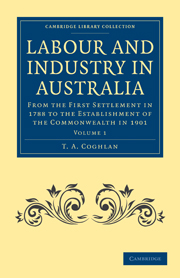 Labour and Industry in Australia
Labour and Industry in Australia Book contents
- Frontmatter
- PREFACE
- Contents
- PART I FROM THE FOUNDATION OF SETTLEMENT TO THE CROSSING OF THE MOUNTAINS
- PART II FROM THE CROSSING OF THE MOUNTAINS TO THE ABOLITION OF THE ASSIGNMENT SYSTEM
- I INTRODUCTION TO THE SECOND PERIOD
- II CONVICT LABOUR: ASSIGNMENT
- III FREE LABOUR
- IV IMMIGRATION
- V THE OCCUPATION OF LAND
- VI AGRICULTURAL AND PASTORAL PURSUITS
- VII THE CURRENCY
- VIII TRADE AND PRICES
- PART III FROM THE ABOLITION OF THE ASSIGNMENT SYSTEM TO THE DISCOVERY OF GOLD
- PART IV FROM THE DISCOVERY OF GOLD TO THE INTRODUCTION OF FREE SELECTION OF LAND BEFORE SURVEY
- Frontmatter
- PREFACE
- Contents
- PART I FROM THE FOUNDATION OF SETTLEMENT TO THE CROSSING OF THE MOUNTAINS
- PART II FROM THE CROSSING OF THE MOUNTAINS TO THE ABOLITION OF THE ASSIGNMENT SYSTEM
- I INTRODUCTION TO THE SECOND PERIOD
- II CONVICT LABOUR: ASSIGNMENT
- III FREE LABOUR
- IV IMMIGRATION
- V THE OCCUPATION OF LAND
- VI AGRICULTURAL AND PASTORAL PURSUITS
- VII THE CURRENCY
- VIII TRADE AND PRICES
- PART III FROM THE ABOLITION OF THE ASSIGNMENT SYSTEM TO THE DISCOVERY OF GOLD
- PART IV FROM THE DISCOVERY OF GOLD TO THE INTRODUCTION OF FREE SELECTION OF LAND BEFORE SURVEY
Summary
As mentioned in the chapter relating to ticket-of-leave men and emancipists, ex-convicts still formed an important element in the free labouring class, but that class contained in addition a number of native-born Australians and free immigrants, who, towards the end of the period, while still numerically less than the bond labourers, became economically more important—so important indeed as to cause the Government to modify its whole attitude towards labour. During the first period few free immigrants of the working class came to Australia, and, owing to the system of land grants then in operation, the majority of these became small farmers. Those who did not obtain grants or who failed to keep them remained ordinary labourers, no distinction being made between them and the bond labourers in the schedules of legal wages issued by the Governors.
Wages declined somewhat at the opening of the second period, and as early as 1824 Sir T. Brisbane, in a despatch to Lord Bathurst, estimated the earnings of mechanics at the sterling value of 3s. 6d. per day. This decline was due to the release from Government employment of a considerable number of convict mechanics, who were assigned to private employers and came into immediate competition with free workmen. Wages continued at the reduced level for some years, and in 1827 the Agent for New South Wales and Van Diemen's Land informed the Chairman of the Emigration Committee in London that the wages of common mechanics were from 3s. to 5s. per day and for the better class from 6s. to 7s.
- Type
- Chapter
- Information
- Labour and Industry in AustraliaFrom the First Settlement in 1788 to the Establishment of the Commonwealth in 1901, pp. 200 - 214Publisher: Cambridge University PressPrint publication year: 2011First published in: 1918
